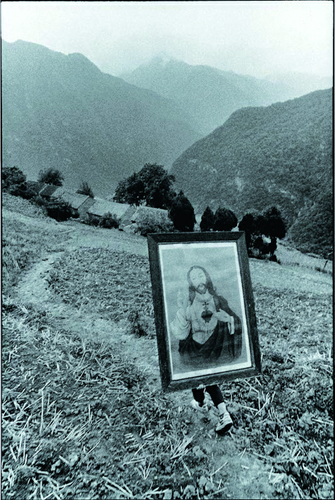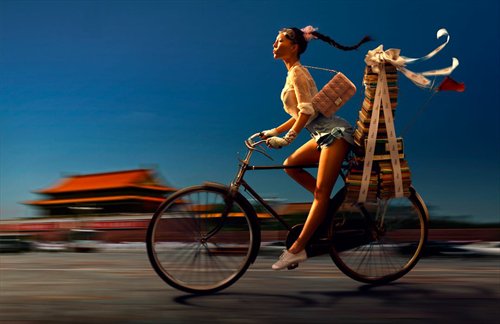Developing photography
Exhibition charts changes of medium across art and reportage in China
In the informative and delightfully presented exhibition Grain to Pixel: A Story of Photography in China, the Shanghai Center of Photography reviews 80 years of photography in China by looking at the signature works of 70 artists.
The period covered by the exhibition spans the 1930s through to the digital age. Curator Karen Smith, who has been immersed in Chinese art and photography for the past 25 years, said that photography has lost none of its power to capture intriguing moments or record the drama of encounters, despite the advent of digital photography and the smartphone snap.
"The shift from grain to pixel is a subtle subtext to any exploration of photography today, but it is one credible version of the story of photography in China," Smith said, adding that while the transition from the "grain" of chemical-process film photography to the pixels of digital cameras took place from the late 1990s to around 2010 worldwide, in China the window of change was far narrower.
Politicized shots
The exhibition begins with photography's presence in China from the 1930s through to the mid-1970s, a time when the practice was strictly guided by politicized ambitions.
With the beginning of China's reform and opening-up in 1978, the drive toward collectivism diminished and personal space increased, while people began to experiment with new ideas and experiences.
Liu Heung Shing, who initiated the exhibition, documented engaging details from the big picture of Beijing, where he lived from 1978 to 1983.
He records a young man on roller skates gliding past a statue of Chairman Mao. Smith calls the image "a subtle juxtaposition of opposing motion that suggests a flying farewell to a bygone era and an enthusiastic embrace of the new."
Meanwhile, photographers like Lü Nan, Liu Zheng and Yuan Dongping aimed at bringing the art form back to focus on real issues through documentary photography.
Alongside patients in mental hospitals, illegal mines, and studies of ethnic minorities in Xinjiang Uyghur and Tibet autonomous regions, Lü's Teenager Carrying Holy Image (pictured below) captures the underground Catholic communities in Shaanxi Province.

Social yardstick
Photography became a yardstick for social progress by the early 1990s. Han Lei, one of the first generation of independent photographers to emerge in the late 1980s, concentrated on life in his hometown of Kaifeng and its seeming social misfits.
Smith believes the images follow Henri Cartier-Bresson's emphasis upon the decisive moment and Diane Arbus' fascination with "difference at once."
Lu Yuanmin, meanwhile, is famed for his naturalist street photography focused on daily life in Shanghai, be it an elderly man carefully finalizing his appearance before stepping out, or a group of retirees playing mahjong, too absorbed to pay any attention to the camera. It is a lively vibe that lives on in the city to this day.
Things got more inventive in the 1990s. Xing Danwen, for example, constructs vistas of contemporary metropolitan life from micro-images of architectural models, and inserts scaled-down shots of individuals (very often the artist herself) into them.
In Urban Fiction No.14, a couple embraces on the balcony of their penthouse, while a couple of floors below a man stands alone by his window.
Direct survey
The development of contemporary art around the time also led to a range of experiments with the camera. "Given its association with truth and reality, photography provided a way to survey the socio-political, economic, and cultural environment in a direct, contemporary way," Smith said.
Wang Qingsong stands out by discussing materialism's influence on culture by portraying himself as Buddha, Shiva, Christ and other revered icons while enmeshed in flashy clusters of consumer products.
"From this type of humanist indignation evolved a methodology for his photographs, which involved ever-greater casts of people and the construction of complex sets to convey his experience of the times. These works represent an extraordinary diversity of process, and of recourses brought to creating them," Smith said.
Elsewhere, Zheng Guogu plays with Andy Warhol's concept of multiples adapted to the taste of every client in his Ten Thousand Customers, in which he takes plain-looking snapshots and prints them in strips like postage stamps across a page.

New synergy
The rise of digital photography in tandem with youth culture, economic growth and materialism gave birth to a new generation of photographers with backgrounds in other fields.
Chi Lei, who describes himself as a specialist in the interactive application of photography and painting, offers I Forgot Who You Are (above) in which a semi-robotic model sits above piles of pink and green high heels. Here, the quirky and super-realism of photography is used to challenge the definition of art and consumer culture.
Another iconic figure of the generation, Chen Man, is famous for exploring the interchangeability between art and fashion, and her habit of cleaning up and perfecting the photographic images she takes to render them highly fantastical.

Photos: Courtesy of Shanghai Center of Photography
In Miss Wan Studies Hard (above), fashion designer Wan Baobao rides a bicycle with books tied up in a huge ribbon on the backseat. She whizzes past Tiananmen Square, which looks almost surreal in the background. It is absolutely glamorous, perhaps too glamorous, but for some it is the true spirit of the age.
Date: Until November 30, 10 am to 6 pm (closed Mondays)
Venue: Shanghai Center of Photography
Address: 2555-1 Longteng Avenue
Admission: Free
Call 6428-9516 for details